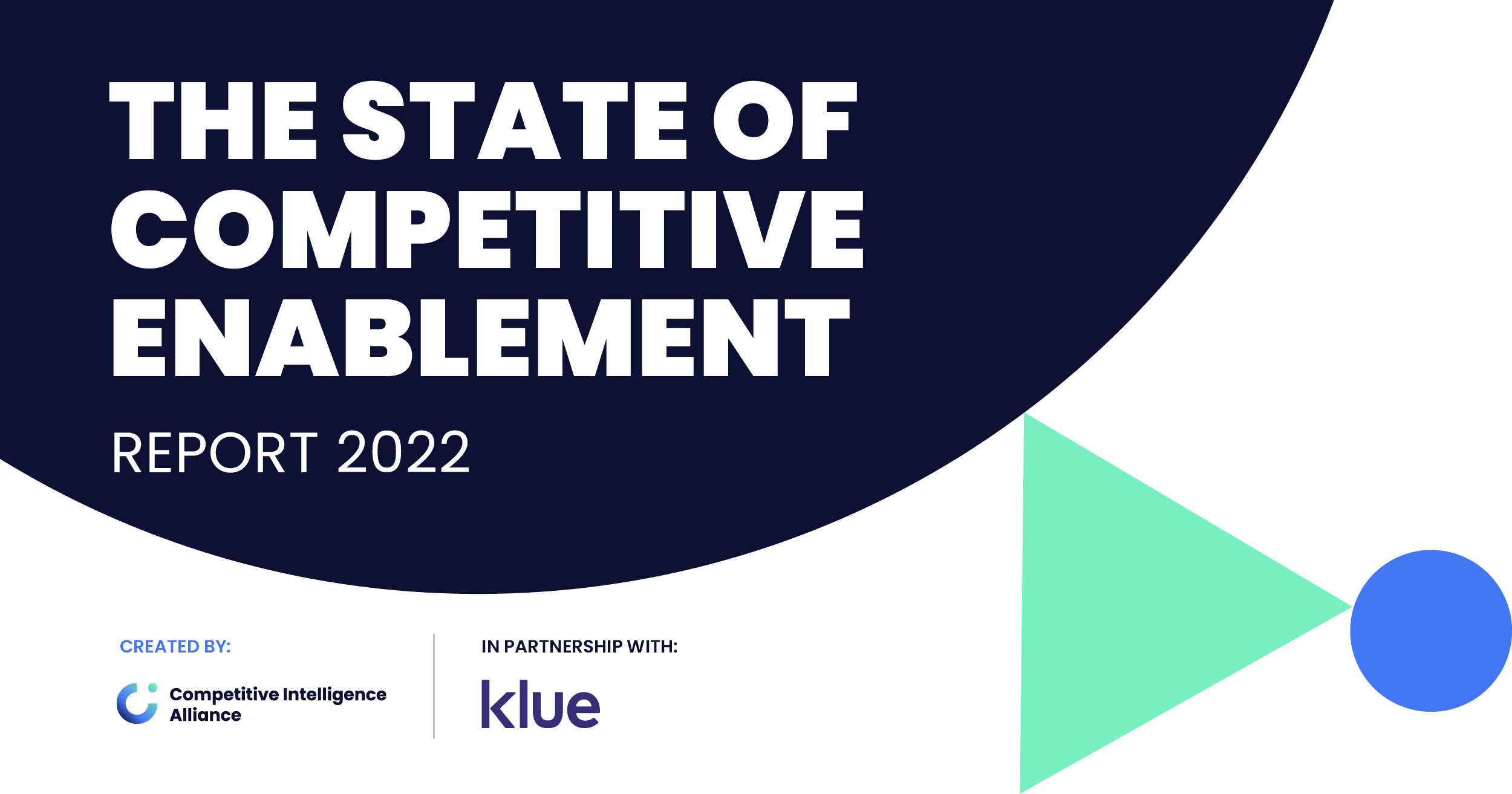From product, to marketing, to executive teams, almost every arm of your org has a vested interest in competitive intelligence. A solid understanding of the competitive landscape means better product roadmaps, more informed strategies, and wiser business decisions.
But it’s your sales team that has the most to gain from competitive intel. 💰
Armed with the right info at the right time, your sales reps’ win rates will soar. And it’s sales enablement teams that work to curate and deliver that information. Together, competitive intelligence and sales enablement pave the way for more closed deals, increased revenues, and greater market share. 📈
In this guide, we cover:
- What sales enablement is, and why it’s important.
- The difference between sales enablement and sales operations.
- Who’s responsible for sales enablement.
- The deliverables competitive enablement teams create.
- How to optimize your enablement content.
- How to measure the ROI of competitive enablement programs.
- Sales enablement best practices.
What is sales enablement?
Sales enablement is a business function focused on giving sales reps the critical information, assets, and content they need to close more deals.
This means identifying exactly what information is most helpful to reps and coming up with effective ways to deliver that info at crucial moments. It means working cross-functionally to create content that makes the sales cycle more efficient.
It also means working together with sales operations to ensure a tech stack is in place to deliver enablement content and track its adoption in line with sales performance.
What is competitive enablement?
Competitive enablement is sales enablement with a twist. It focuses specifically on enabling reps to win in competitive deals. That is, deals where your product is in a close-run race with an alternative product.
Competitive enablement content focuses on tactfully dismissing competitors to make them appear less viable as alternatives. At the same time, this content aims to present your own product favorably.
Usually, this involves recognizing the competitor’s strengths, but explaining why you think these don’t meet the customer’s needs as well as your product can. Or, why you don’t think the problems your competitor’s product solves well are the most pressing problems the market is facing.
Why is sales enablement important?
Sales is a busy job. It’s target-driven, and often those targets involve being on the phone for most of the day.
That leaves sales reps with little time to become experts on new product developments, feature updates, or competitive disruptions.
Sales enablement watches and analyzes sales performance, delivering strategic direction at key moments, ready to fuel the rep with what they need most.
In short, sales enablement makes your sales teams more effective. This means more won deals, and more revenue for the business.
What’s the difference between sales enablement and sales operations?
Sales operations (sales ops) involves managing and overseeing the day-to-day processes that allow sales reps to do their jobs.
This often involves managing the CRM (customer relationship management software), and training reps in its use. It can also involve:
- Refining day-to-day sales techniques. 🔎
- Hiring and onboarding those new hires. 👩💻
- Tracking sales metrics and KPIs. 📈
Crucially, these all relate to your business’ systems of selling. That’s also why sales operations professionals tend to look after the sales enablement tools and software that can help automate repetitive tasks and deliver crucial information to reps at the right times.

Who owns sales enablement?
Sales enablement professionals act as a critical link between your sales and marketing teams. The most effective sales enablement practitioners will be excellent communicators, gathering intel from both groups, and delivering useful, actionable assets to sales teams.
That’s why, in smaller businesses without a dedicated sales enablement function, the responsibility is often distributed between the product and marketing teams. When the business is mature enough, it will formalize the sales enablement responsibility, assigning it to one or two people.
These will most often be members of product and/or marketing teams, since they’ll be best placed to produce material that informs sales reps on the benefits of their products.
What’s the role of a sales enablement manager?
Sales enablement managers look to grow business revenue through their enablement initiatives. These involve creating learning materials and resources to help sales close more deals.
The manager is often in charge of a team of sales enablement professionals who work on developing and delivering these materials and resources.
The sales enablement manager acts as a critical go-between for the marketing and sales teams, gathering data and analyzing it for new opportunities to improve the sales process.
They’ll design, develop, and deploy enablement programs with the help of their team, and report to the leadership team on the results of these programs.

What deliverables does sales enablement create?
Cast your eyes down the list of subheadings in this section. Anything seem strange to you?
It might seem odd to argue that a blog post could constitute ‘enabling’ your sales reps. Especially if the sales enablement arm of the business doesn’t write that post itself.
And after all, a blog post doesn’t directly increase your sales reps’ powers of persuasion.
But that’s not the point. The point of sales enablement content is to create a toolbox of assets your reps can pull from to ease the sales process as needed. To that end, anything that helps your reps win more deals is “enablement content”.
For example, an account manager or sales enablement lead might look to offer a steak dinner to viable new accounts. Odd? Perhaps. But if it helps reps win deals? Then it’s sales enablement.
Still, of all the infinite forms sales enablement could take, there are a finite number of forms it typically does take. That’s because, of all these possibilities, there are certain tried and true forms of enablement collateral that do their job better than the rest.
Here are some of them:
- Battlecards. ⚔️
- Informational content. ℹ️
- Product demos. 👨💻
- Landmines. 💣
- Sales training sessions. 🏋️♂️
Battlecards ⚔️
Everyone loves to talk about competitive battlecards. Done right, they’re every salesperson’s best friend.
At their core, battlecards are all about delivering crucial cliff notes on competitors. As the name implies, when the ‘battle’ is on, you best bring the heavy weaponry. In this context, that means arming your reps with the information they need to persuade prospects your competitors aren’t the right fit for them.
Remember, the purpose of sales enablement is to win you more deals. That means giving reps the intel they need to be persuasive, especially in difficult conversations.
When competitors come up (as they inevitably will), battlecards play a pivotal role in the deal’s outcome. When your rep can see, at a glance, that competitor X just launched a great new feature, they don’t have to sweat when a customer brings it up. They can more or less read the ready-made reply right off the battlecard.
This brings us to another of the battlecard’s key strengths: they’re not just fast to digest, they’re fast to update.
Your reps can’t know everything. As every competitive intelligence practitioner knows, staying on top of crucial competitor developments, deciding what (if anything) should be done about them, and keeping all arms of the business informed and on the same page is a full-time job. Your sales rep doesn’t have the time to do that themselves while trying to hit targets.
Battlecards solve this problem. They deliver deal-winning information to the rep asynchronously for them to access when they need it most. And they’re easy to keep updated when new intel comes along.
Plus, when content’s easy to update, it’s easy to stay on top of this crucial task even when resources are thin.
Informational content ℹ️
Sales enablement pros have to work cross-functionally to identify, then deliver, informative content. Content, that is, that informs prospective customers about your products and services while keeping interest high and moving them along the sales funnel.
As we mentioned, the content can take many different forms. It just has to help persuade the customer.
Customers are more receptive to informational content at certain points in the sales cycle. If the content is long, colder leads might shy away from the time commitment required to work through it.
To a warmer prospect looking to make a decision soon, a detailed product brochure might be a welcome aid to the decision-making process.
Product demos 👨💻
Product demos, like informational content, can come in and save the day at certain points in the sales process.
Whether pre-recorded video, or a live-hosted webinar, product demonstrations follow the classic “show, don’t tell” mantra marketers live by. Rather than telling them what your product does and why it’s great, they get a chance to see it with their own eyes.
Demos enable sales teams by showing prospects what they’ll be buying, removing risk and uncertainty from the equation. This is persuasive in itself and can help move buyers through the funnel.
Landmines 💣
Remember the Christopher Nolan movie, Inception? Where Leo DiCaprio, Tom Hardy and friends infiltrate people’s dreams to conduct the heist-worthy act of planting ideas?
That’s what landmines set your reps up to do.
Sometimes included in battlecards, landmines are a conversational trip hazard designed to disqualify a competitor before the customer begins to seriously consider their product.
But they do so in such a way the prospect feels like they had the idea themselves.
This often takes the form of a question about an area you know your competitor is weak. If you know your competitor’s video calling software is slow and stuttery, the landmine might be to ask your customer how important a stable, reliable service is to them.
The value here is that, even if this competitor never comes up in conversation, your prospect has now considered how mission-critical stability is to them. Now, when they look for proof that your competitor’s service is reliable they’ll discover for themselves that yours is the best option for them.
Sales training sessions 🏋️♂️
Sales enablement assets don’t mean a thing if your reps don’t use them. And that’s why sales training sessions, another key deliverable for the sales enablement team, are so important.
Sales training sessions achieve a number of things:
- They introduce your reps to the enablement collateral you’ve created. 💡
- They give reps a chance to offer feedback early while the stakes are low. 📣
- They give you a chance to demonstrate your investment in reps’ success, building rapport. 🤝
- They help you achieve buy-in and increase adoption rates for your content. 👏
There’s nothing worse than creating great collateral before a call with a big lead, assuming the content is easy to use, and watching your rep crash and burn. All because you didn’t introduce them to the content beforehand.
Using enablement content might sound simple, but let’s think about what’s involved from the rep’s point of view.
Your rep has to see where the conversation’s leading and spot the potential danger up ahead. Then they have to engage with a content delivery platform they might be unfamiliar with while keeping the conversation going. Then they have to find the content, read and digest its contents, and turn that into a ready response.
For a rep under pressure, there’s a lot going on there. 😮💨
Conduct training sessions, and take the time to engage in some role play. You’ll discover weaknesses in your content with plenty of time to spare.
How to optimize your sales content
The best sales enablement content is:
- Informative.
- Scannable.
- Up to date.
If your enablement content doesn’t check all of these boxes, there’s work you can do to improve it.
We know, “informative” sounds like an obvious one. But your content needs to tell reps the right things. And you can only deliver your sales reps what they need to know if you establish a good working relationship with them.
That’s why getting close to your sales reps - by owning training initiatives and blocking out time to talk with them - is the first key step in optimizing your enablement content. Understand your reps’ needs.
One such need is that your sales content be scannable. Reps have to be able to pull up the exact piece of content they’re looking for, then find exactly the information they need, even if they’re unfamiliar with the content itself.
That means laying out your content visually in a way that makes all the contained information digestible.
Still not sure how to proceed?
Tracking content adoption helps you identify why certain reps aren’t engaging with your content. In turn, this can uncover opportunities to improve it.
Block out time to speak with these individuals and identify what’s paining them. Enablement content should make it easier for reps to close deals, hit their targets, and make commissions. They should be excited to see and use the content you prepare. If they’re not, something’s wrong. Get to the bottom of what that is and you’ll know exactly what steps to take your collateral to the next level.

Sales enablement technology and tools
Sales enablement platforms, tools, and software are one of the most highly adopted categories of tools in the competitive intelligence tech stack, according to our upcoming Competitive Intelligence Tools of Choice Report 2023. Amongst our respondents, sales enablement platforms had a 69% adoption rate, making this the second-most highly adopted category of the seven we surveyed for.
Sales enablement platforms help CI practitioners deliver their insights to sales teams and collaborate more effectively with enablement teams. They also give valuable feedback on which enablement content is having the most impact, as well as on adoption rates.
For product marketers conducting CI as a part of their role, sales enablement platforms offer invaluable feedback on the revenue impact of your competitive intelligence deliverables.
Measuring the ROI of sales enablement
So how do you actually know if your sales enablement program is doing well?
It’s easy to measure the performance of your sales team, after all. How much revenue have they generated for the company in closed deals in a given timeframe?
How to measure the performance of your sales enablement team, on the other hand, might not be so obvious. 🤔
Sales enablement has four key goals. Each is able to generate ROI in its own ways, so it’s worth tracking and monitoring your enablement program’s success at meeting each goal individually.
The four goals of sales enablement are to:
- Accelerate revenue.
- Cut costs.
- Reduce risk.
- Improve engagement.
To determine your enablement program’s effectiveness in hitting each goal, you’re going to want to track a number of different categories of metrics:
- Sales performance and revenue metrics. 💸
- Onboarding metrics. 🙋♀️
- Content adoption and effectiveness metrics. ⬆️
- Sales enablement platform adoption and effectiveness metrics. 💻
- Qualitative metrics. 🗣️
What might these early signs of success look like?
When you manage to bring new hires up to speed in four working days instead of five, you’ve cut onboarding time by 20%. There’s measurable ROI there.
Or when enablement content adoption by your reps increases by 17%. That’s a measurable return on investment too.
Either of these is an early sign that things are moving in the right direction. Stack these early wins up and the revenue metrics will follow.

Sales enablement best practices
With markets more competitive than ever before, organizations need to be proactive when it comes to customer acquisition. That means optimizing their sales processes and enabling reps with solid sales enablement content.
But what does the optimal implementation of a sales enablement program look like?
First, make sure the flow of information goes both ways. As we’ve alluded to, your reps themselves are a great resource. They’re the ones you’re looking to help via your sales enablement initiatives, so get to know where they need that support.
In other words, don’t just deliver information at them. Get their thoughts on what they’d like to see, what would be helpful for them, and what they think of the sales enablement content you’ve produced already.
Second, conduct regular training sessions to get feedback early in the process. You’ll learn what your reps like and don’t like, give them a chance to get used to the format of your enablement content, and earn their respect by showing you’re invested in their performance and value their opinions.
Third, make sure you refresh your CI and enablement assets at regular intervals. If your reps get caught with outdated content, it makes the business as a whole seem out of touch with what’s happening in the market.
You already know that, if your prospects are to trust your products, you need to make the most of every interaction as an opportunity to appear sharp, confident, and aware. That’s impossible for your reps if the content they rely on to close deals is outdated.
Want to learn more about sales enablement best practices? Here are 5 enablement best practices to skyrocket win rates.
Looking to learn even more about competitive enablement?
Download the State of Competitive Enablement Report 2022, produced in partnership with Klue.
Inside, we bring you valuable insights on:
- Competitor growth.
- Tips for remote workers.
- Buyer education.
- Enablement challenges.
- Proving ROI.






.png?v=09cf73b4b5)